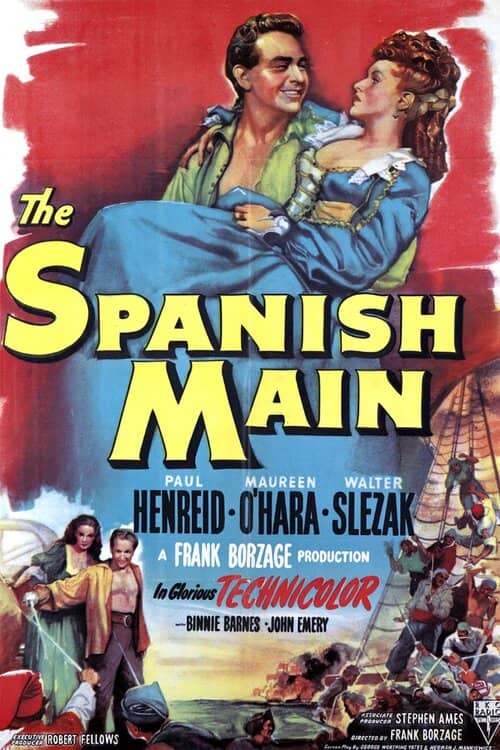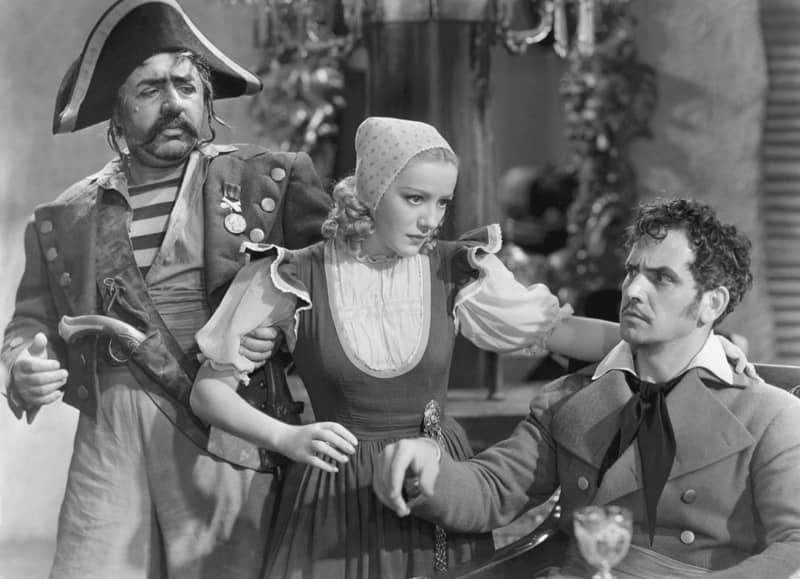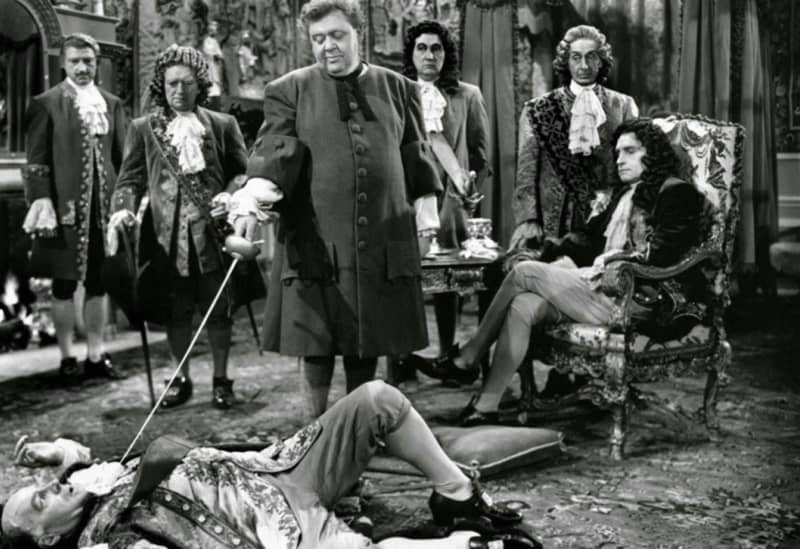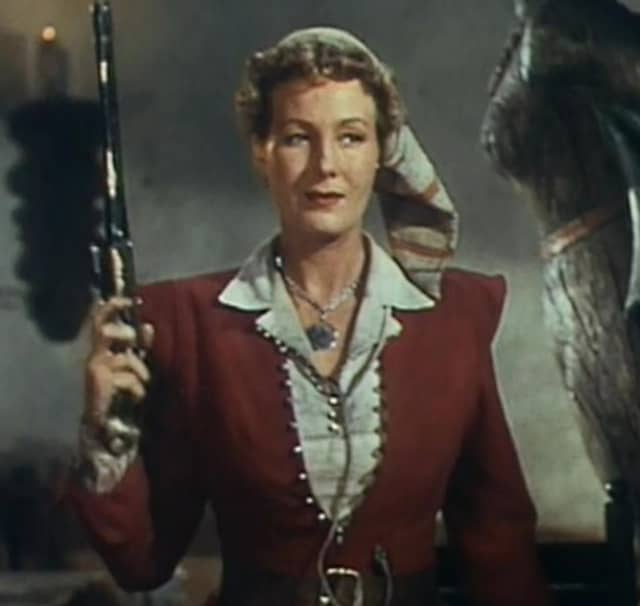Ellsworth’s Cinema of Swords: Old School Pirates
The Spanish Main (Warner Bros, 1945)
“Every normal man must be tempted, at times, to spit upon his hands, hoist the black flag, and begin slitting throats.” –H. L. Mencken, 1919. And when more than during the winter holiday season, the Festival of the Taillights? Bring me my whetstone and cutlass! This week we celebrate old school Hollywood pirate epics, stories of charming rogues and swaggering scallywags. Come on, me lads, heave to and turn aside from It’s a Wonderful Life and A Christmas Carol, for it be time t’ wallow in a different nostalgia, one with more pointy edges to it. An’ ye can lay to that.
The Buccaneer
Rating: ***
Origin: USA, 1938
Director: Cecil B. DeMille
Source: Olive DVD
This may be the only patriotic American pirate movie with a president in it, except for the remake from twenty years later. It’s based on the 1930 novel Lafitte the Pirate by Lyle Saxon, which I haven’t read, but if its plot has as little to do with history as this movie, Mr. Saxon has a lot to answer for. High concept: “Jean Lafitte helps ol’ Andy Jackson beat the British at the Battle of New Orleans.” This is not only a sure-fire can’t-miss basis for a Hollywood movie, it even actually happened. Just nothing like the way it’s depicted in The Buccaneer.
All right, so this is claptrap — but is it entertaining claptrap? In the main, it is, mostly because it knows it’s claptrap and therefore doesn’t take itself very seriously. This is a relief, frankly, after DeMille’s pompous and overblown Cleopatra and The Crusades, and shows he still knows how to tell a story with a light hand. But this is also flag-waving, chest-thumping American history as told in the mid-twentieth century, and therefore more about America’s idea of itself than what really occurred.
Jean Lafitte, the titular buccaneer, is played by Fredric March, one of the most respected leading men of the Thirties, acclaimed in roles both dramatic and romantic. His Captain Lafitte is a dark and curly-haired dandy who mocks the respectable in a suave French accent while secretly aspiring to gentility, more an unorthodox free-trading entrepreneur than an unscrupulous cutthroat. The real Lafitte was the last of the Caribbean pirates, a double-dealing scoundrel with no principles to speak of — but that won’t do for DeMille, who must have a heroic privateer who respects the American flag and will raid only foreign shipping.
Claptrap, but it provides the film some early conflict between Lafitte and a captain who disobeys his orders and sinks an American ship. This gives March a chance to conduct a boarding action, show off his piratical grit, and then turn around and display his decency by saving the life of a captive, a Dutch woman named Gretchen, played for laughs by Franciska Gaal.
She’s not the only funny-foreigner character in the film: for DeMille, the melting pot of New Orleans is an opportunity for a parade of cartoon ethnics and racial stereotypes. This is irksome, hard to forgive, and unfunny, with one exception: the ursine Akim Tamiroff and his mighty mustache in the role of Dominique Youx, a former Napoleonic cannoneer in the service of Lafitte. (True story.) Tamiroff becomes Gretchen’s protector, and his blustering ebullience is one of the chief pleasures of this film.
Other pleasures include the re-creation of Lafitte’s legendary pirate haven of Barataria, his battalion of buccaneers gliding through the bayous on their long, narrow flatboats, and the swaggering and smirking Anthony Quinn as Lafitte’s shady lieutenant. (Quinn’s presence seems to be statutorily required in every pirate movie of the time). But best of all is the dawning realization that the so-serious Fredric March has a genuine talent for sly comedy.
Over an hour into the movie the other major historical figure finally appears: Hugh Sothern as General Andrew Jackson, in a fun over-the-top portrayal of Old Hickory, outdone only by his aide, the even-more-cartoonish frontiersman Ezra Peavey (Walter Brennan, in an early triumph). Brennan even out-hams Akim Tamiroff. Anyway, the British are coming! After a tense negotiation held at mutual gunpoint, Jackson and the outlawed Lafitte join forces—but not until Lafitte slays a British-paid traitor in a fine cutlass duel and frees his captive men from prison in the nick of time.
And then the Battle of New Orleans is on! In the big finale DeMille reminds us that, if nothing else, that son of a bitch sure knew how to set up a shot. Lafitte and his men are given the critical center of the line of defense, whereas historically they held the extreme left flank, but what the hell: it’s Hollywood. Flags wave, redcoats marching to skirling bagpipes are no match for Jackson’s squirrel hunters and Napoleon’s cannoneer, and America is saved from perfidious Albion. So, it’s a happy ending for everyone, right? Well, not so much, because pirates. No spoilers here: see it for yourself.
Captain Kidd
Rating: ***
Origin: USA, 1945
Director: Rowland V. Lee
Source: American Home Treasures DVD
Charles Laughton had a strange career for a movie star. Enormously talented, with an outsized screen presence despite his modest stature, he made an early name for himself in the Thirties playing big roles like King Henry VIII, the Emperor Nero, and Captain Bligh. But no matter how talented he was, Laughton was far from conventionally handsome and only grew more homely with time; his looks limited his options, and by the 1940s about the only lead parts he could get were in low-budget melodramas like Captain Kidd.
Though theoretically based on the life of the historical pirate, other than a few names and some disconnected incidents, this movie has less to do with history than with including as many pirate-movie tropes as possible: rascally new crew members signing the Articles; buccaneers burying their ill-gotten treasure in a hidden cave; a sword duel over possession of a captive lady; a candle burning down to set off a ship’s powder magazine; even a medallion that reveals the wearer’s true parentage.
All good fun, but this film’s principal pleasures come from watching Laughton’s portrayal of the supremely duplicitous William Kidd, who indulges in treachery, corruption, cruelty, and murder because he genuinely enjoys it, and openly revels in his utter lack of scruples. When he’s lying to someone he plans to betray (i.e., everyone), he can scarcely conceal his evil glee. At one point John Carradine calls him a cold-blooded shark, to which Laughton replies, “Ah, you flatterer!”
Speaking of the gaunt and ever-sinister John Carradine, he may be the best of the fine character actors supporting Laughton in this film, but he’s not the only one: there’s Gilbert Roland as another of Kidd’s lieutenants, the suave but avaricious Spaniard Lorenzo; the haughty Henry Daniell as King William III; and Reginald Owen as the snooty Shadwell, the butler Kidd hires to teach him how to act like “a person of quality.”
The only wrong note comes from the casting of Randolph Scott as Adam Mercy, the ex-pirate who joins Kidd’s crew as master gunner but whose manners and attitude betray an aristocratic background. The problem is that Scott, a tall square-jawed American best known as a two-fisted cowboy in Western movies, is about as aristocratic as beer and about as piratical as an Eagle Scout. As the king’s infiltrator in Kidd’s crew, it’s just unbelievable that Kidd and his cutthroats would be taken in by him for a moment. But this is Hollywood, so in the end cowboy virtue wins out over ruthless duplicity. At least Laughton gets in a mocking final speech.
Fun fact: according to Nikita Khrushchev’s memoirs, this was one of Josef Stalin’s favorite films. He’s said to have been delighted by Laughton’s portrayal of the unrepentant and utterly unprincipled pirate captain. Is good!
The Spanish Main
Rating: ****
Origin: USA, 1945
Director: Frank Borzage
Source: Warner Bros. DVD
This is a fine Technicolor pirate epic, grand and satisfying, the story carried by the energy of its three marquee stars and a surprise stand-out fourth. Paul Henreid, best known as Victor Laszlo in Casablanca, is the heroic lead, a Dutch ship captain who is captured and enslaved when a storm drives his peaceful ship aground in Spanish colonial waters. He escapes and becomes a feared pirate captain known as the Barracuda, preying exclusively on Spanish shipping. You might not think the stiff and rather serious Henreid could buckle a swash like Errol Flynn or Tyrone Power, but you’d be wrong: his Captain Barracuda displays an edge of mocking arrogance that enables him to command buccaneers and defy Spaniards, he looks good in pirate garb, and he knows what to do when you put a sword in his hand.
The Barracuda captures a Spanish ship bearing our second star, the radiant Maureen O’Hara as the Condesa Francisca, on her way to marry the Viceroy of New Granada — the very man who is the particular target of the Barracuda’s campaign of revenge. When the Barracuda meets Francisca, sparks fly, and he decides to marry her just to spite the viceroy — or is there another motive? The condesa initially refuses, but then she finds a reason of her own to agree, sort of. The two maneuver around each other toward marriage like a pair of tall ships tacking in to a boarding action. Here, as with her role in The Black Swan, O’Hara has to find a means to give herself away without giving herself up. She does it, though, and O’Hara has the chops to make you believe it.
The viceroy, Don Juan, isn’t happy about any of this, but when Don Juan is unhappy, we’re delighted, because he’s played by Walter Slezak, and boy, do we love him when he’s angry! Slezak is basically reprising his governor’s role from The Princess and the Pirate, but the viceroy here is much smarter, more menacing, and equipped with a wicked sense of humor. He’s quick-witted, mean, and oozes contempt for his inferiors, i.e., everyone. It takes everything the Barracuda and Francisca have to defeat him, and even so it’s a near-run thing.
However, before our two romantic leads run afoul of the wicked viceroy’s final trap, they put in to Tortuga for some roistering, revelry, and a spot of getting-betrayed-by-your-allies-because-what-do-you-expect-from-pirates? One of these allies is Binnie Barnes playing the historical female pirate Anne Bonny, and The Spanish Main is worth watching for her performance alone. This is, I believe, the first appearance of Anne Bonny on screen, and in Barnes’s portrayal she’s tough, jealous, but fiercely independent and takes no guff from anyone. In this she resembled Barnes herself, who had a long career in the movies from the Twenties to the Seventies, but always refused to play submissive roles: give me anything, she said, “as long as I don’t have to be a sweet woman.” Amen to that.
Where can I watch these movies? I’m glad you asked! Many movies and TV shows are available on disk in DVD or Blu-ray formats, but nowadays we live in a new world of streaming services, more every month it seems. However, it can be hard to find what content will stream in your location, since the market is evolving and global services are a patchwork quilt of rights and availability. I recommend JustWatch.com, a search engine that scans streaming services to find the title of your choice. Give it a try. And if you have a better alternative, let us know.
Previous installments in the Cinema of Swords include:
The Book Was Better
Shogunate’s End
Peak Musketeers
Lone Wolf and Cub, Part 2
Arthur, King of the Britons
Sinbads Three
Premium Peplum: Top Hercs
Fight Direction by William Hobbs
Mash-Up or Shut Up
Classics on Screen — 1977
Wuxia in the Time of Kung Fu
So Many Prisoners of Zenda
Seventies Hall of Shame
The Year of Shogun
1981: The Old Order Changeth
The Barbarian Boom, Part 1
LAWRENCE ELLSWORTH is deep in his current mega-project, editing and translating new, contemporary English editions of all the works in Alexandre Dumas’s Musketeers Cycle, with the fifth volume, Between Two Kings, coming in July from Pegasus Books in the US and UK. His website is Swashbucklingadventure.net.
Ellsworth’s secret identity is game designer LAWRENCE SCHICK, who’s been designing role-playing games since the 1970s. He now lives in Dublin, Ireland, where he’s writing Dungeons & Dragons scenarios for Larian Studios’ Baldur’s Gate 3.




Enjoyed this installment even more than usual. Plenty of sharp and amusing insights on movies for which you clearly have a deep and abiding affection.
“The problem is that Scott, a tall square-jawed American best known as a two-fisted cowboy in Western movies, is about as aristocratic as beer and about as piratical as an Eagle Scout.”
I snorted with laughter. Hey, I love Randolph Scott but…yeah.
Another Ellsworth’s Cinema of Swords??? An Old Question Answered!
Great post, Mr. Ellsworth! Sir Charles Laughton, Walter Slezak, what great villains! Now, all three of these films I found entertaining but The Spanish Main especially so, although I didn’t understand exactly why.
I think I’ve mentioned in the past the fact that pretty much every male in my family for four generations had a crush on Maureen O’Hara (how not?) The womenfolk in my family didn’t mind (I think they considered her a cousin) and the Spanish Main was one of movies that was one the list of films that any of us was happy to watch at any time, but I never realized why until I saw that picture of Anne Bonny towards the end of the post:
Two of my aunts looked like Binnie Barnes.
Thank you, Mr. Ellsworth.
Also in THE SPANISH MAIN. a major supporting role for Fritz Leiber, Sr., long the director of traveling Shakespearean troupe and, of course, the father of Fritz Leiber, Jr., occasional film actor and major fantastica writer, among other things. It’s also notable how much the two Fritzes looked alike, at least in their respective middle years.